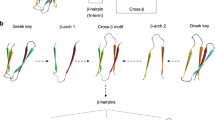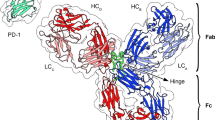Abstract
We have taken a computational approach to design mutations that stabilize a large protein domain of ∼200 residues in two alternative conformations. Mutations in the hydrophobic core of the αMβ2 integrin I domain were designed to stabilize the crystallographically defined open or closed conformers. When expressed on the cell surface as part of the intact heterodimeric receptor, binding of the designed open and closed I domains to the ligand iC3b, a form of the complement component C3, was either increased or decreased, respectively, compared to wild type. Moreover, when expressed in isolation from other integrin domains using an artificial transmembrane domain, designed open I domains were active in ligand binding, whereas designed closed and wild type I domains were inactive. Comparison to a human expert designed open mutant showed that the computationally designed mutants are far more active. Thus, computational design can be used to stabilize a molecule in a desired conformation, and conformational change in the I domain is physiologically relevant to regulation of ligand binding.
This is a preview of subscription content, access via your institution
Access options
Subscribe to this journal
Receive 12 print issues and online access
$189.00 per year
only $15.75 per issue
Buy this article
- Purchase on Springer Link
- Instant access to full article PDF
Prices may be subject to local taxes which are calculated during checkout




Similar content being viewed by others
References
Springer, T.A. Nature 346, 425–433 (1990).
Michishita, M., Videm, V. & Arnaout, M.A. Cell 72, 857–867 (1993).
Diamond, M.S., Garcia-Aguilar, J., Bickford, J.K., Corbi, A.L. & Springer, T.A. J. Cell Biol. 120, 1031–1043 (1993).
Lee, J.-O., Bankston, L.A., Arnaout, M.A. & Liddington, R.C. Structure 3, 1333–1340 (1995).
Lee, J.-O., Rieu, P., Arnaout, M.A. & Liddington, R. Cell 80, 631–638 (1995).
Qu, A. & Leahy, D.J. Proc. Natl. Acad. Sci. USA 92, 10277–10281 (1995).
Qu, A. & Leahy, D.J. Structure 4, 931–942 (1996).
Emsley, J., King, S.L., Bergelson, J.M. & Liddington, R.C. J. Biol. Chem. 272, 28512–28517 (1997).
Baldwin, E.T. et al. Structure 6, 923–935 (1998).
Nolte, M. et al. FEBS Lett. 452, 379–385 (1999).
Rich, R.L. et al. J. Biol. Chem. 274, 24906–24913 (1999).
Huang, C. & Springer, T.A. J. Biol. Chem. 270, 19008–19016 (1995).
Li, R., Rieu, P., Griffith, D.L., Scott, D. & Arnaout, M.A. J. Cell Biol. 143, 1523–1534 (1998).
Zhang, L. & Plow, E.F. Biochemistry 38, 8064–8071 (1999).
Emsley, J., Knight, C.G., Farndale, R.W., Barnes, M.J. & Liddington, R.C. Cell 101, 47–56 (2000).
Springer, T.A. Proc. Natl. Acad. Sci. USA 94, 65–72 (1997).
Oxvig, C., Lu, C. & Springer, T.A. Proc. Natl. Acad. Sci. USA 96, 2215–2220 (1999).
Perutz, M.F. Q. Rev. Biophys. 22, 139–237 (1989).
Dahiyat, B.I. & Mayo, S.L. Science 278, 82–87 (1997).
Malakauskas, S.M. & Mayo, S.L. Nature Struct. Biol. 5, 470–475 (1998).
Street, A.G. & Mayo, S.L. Structure 7, R105–R109 (1999).
Gordon, D.B., Marshall, S.A. & Mayo, S.L. Curr. Opin. Struct. Biol. 9, 509–513 (1999).
Lasters, I., De Maeyer, M. & Desmet, J. Protein Eng. 8, 815–822 (1995).
Harbury, P.B., Plecs, J.J., Tidor, B., Alber, T. & Kim, P.S. Science 282, 1462–1467 (1998).
Oxvig, C. & Springer, T.A. Proc. Natl. Acad. Sci. USA 95, 4870–4875 (1998).
Lu, C., Oxvig, C. & Springer, T.A. J. Biol. Chem. 273, 15138–15147 (1998).
Diamond, M.S. & Springer, T.A. J. Cell Biol. 120, 545–556 (1993).
Lu, C. & Springer, T.A. J. Immunol. 159, 268–278 (1997).
Petruzzelli, L., Maduzia, L. & Springer, T. J. Immunol. 155, 854–866 (1995).
Humphries, M.J. & Newham, P. Trends Cell Biol. 8, 78–83 (1998).
Loftus, J.C. & Liddington, R.C. J. Clin. Invest. 99, 2302–2306 (1997).
Knorr, R. & Dustin, M.L. J. Exp. Med. 186, 719–730 (1997).
Dahiyat, B.I. & Mayo, S.L. Proc. Natl. Acad. Sci. USA 94, 10172–10177 (1997).
Dill, K.A. Biochemistry 29, 7133–7155 (1990).
Dahiyat, B.I. & Mayo, S.L. Protein Sci. 5, 895–903 (1996).
Dahiyat, B.I., Gordon, D.B. & Mayo, S.L. Protein Sci. 6, 1333–1337 (1997).
Street, A.G. & Mayo, S.L. Fold. Des. 3, 253–258 (1998).
Casimiro, D.R., Toy-Palmer, A., Blake, R.C.d. & Dyson, H.J. Biochemistry 34, 6640–6648 (1995).
Prodromou, C. & Pearl, L.H. Protein Eng. 5, 827–829 (1992).
Kishimoto, T.K., O'Connor, K., Lee, A., Roberts, T.M. & Springer, T.A. Cell 48, 681–690 (1987).
Kleywegt, G.J. & Jones, T.A. Acta Crystallogr. D 50, 178–185 (1994).
Carson, M. Methods Enzymol. 277, 493–505 (1997).
Acknowledgements
We thank M. Ferzly for technical assistance. This work was supported by the NIH.
Author information
Authors and Affiliations
Corresponding authors
Rights and permissions
About this article
Cite this article
Shimaoka, M., Shifman, J., Jing, H. et al. Computational design of an integrin I domain stabilized in the open high affinity conformation. Nat Struct Mol Biol 7, 674–678 (2000). https://doi.org/10.1038/77978
Received:
Accepted:
Issue Date:
DOI: https://doi.org/10.1038/77978
This article is cited by
-
rstoolbox - a Python library for large-scale analysis of computational protein design data and structural bioinformatics
BMC Bioinformatics (2019)
-
The dark sides of capillary morphogenesis gene 2
The EMBO Journal (2012)
-
Contributions of Microorganisms to Industrial Biology
Molecular Biotechnology (2008)
-
Computational Comparison Studies of Quadratic Assignment Like Formulations for the In Silico Sequence Selection Problem in De Novo Protein Design
Journal of Combinatorial Optimization (2005)
-
Sensing the environment: a historical perspective on integrin signal transduction
Nature Cell Biology (2002)



